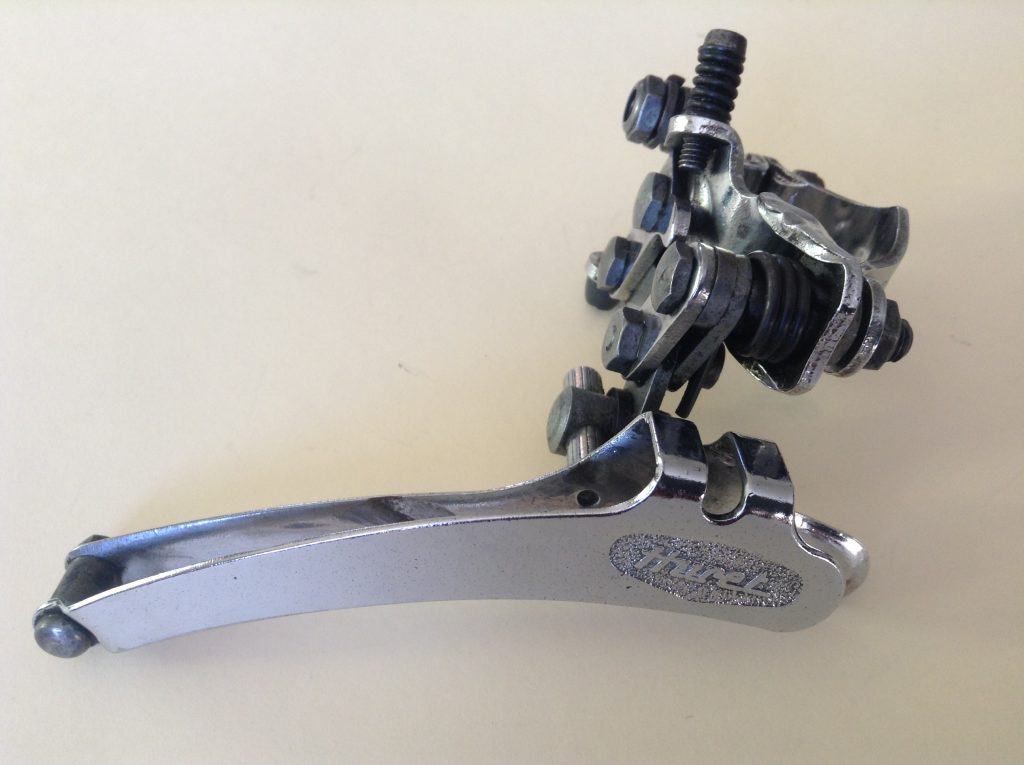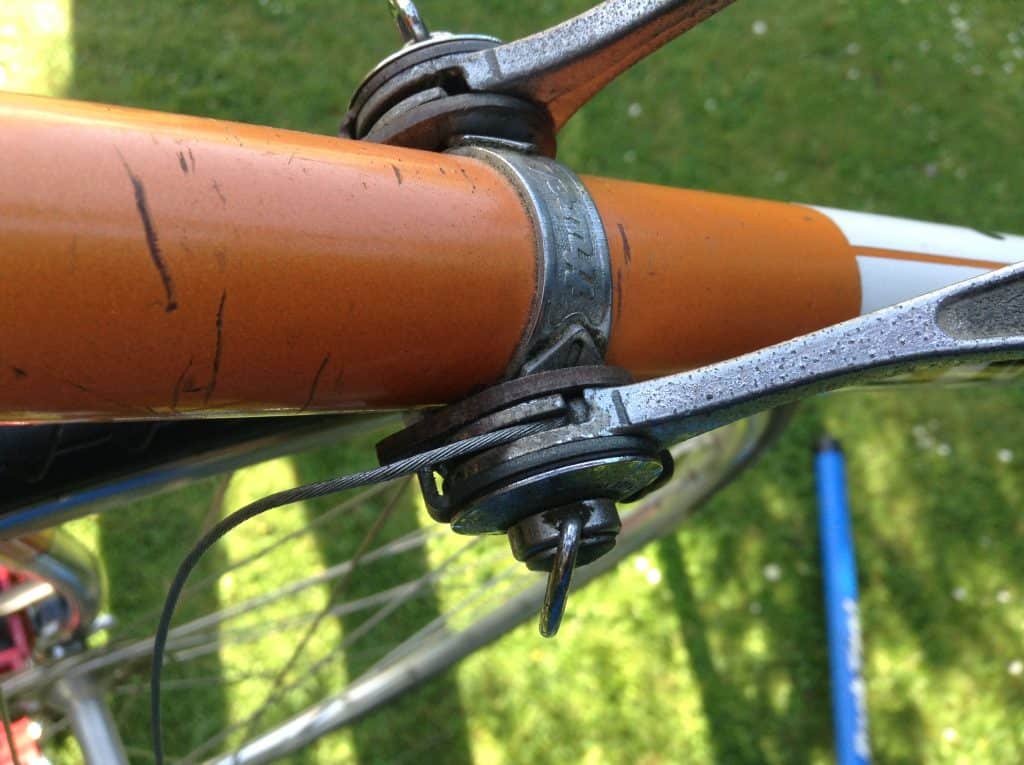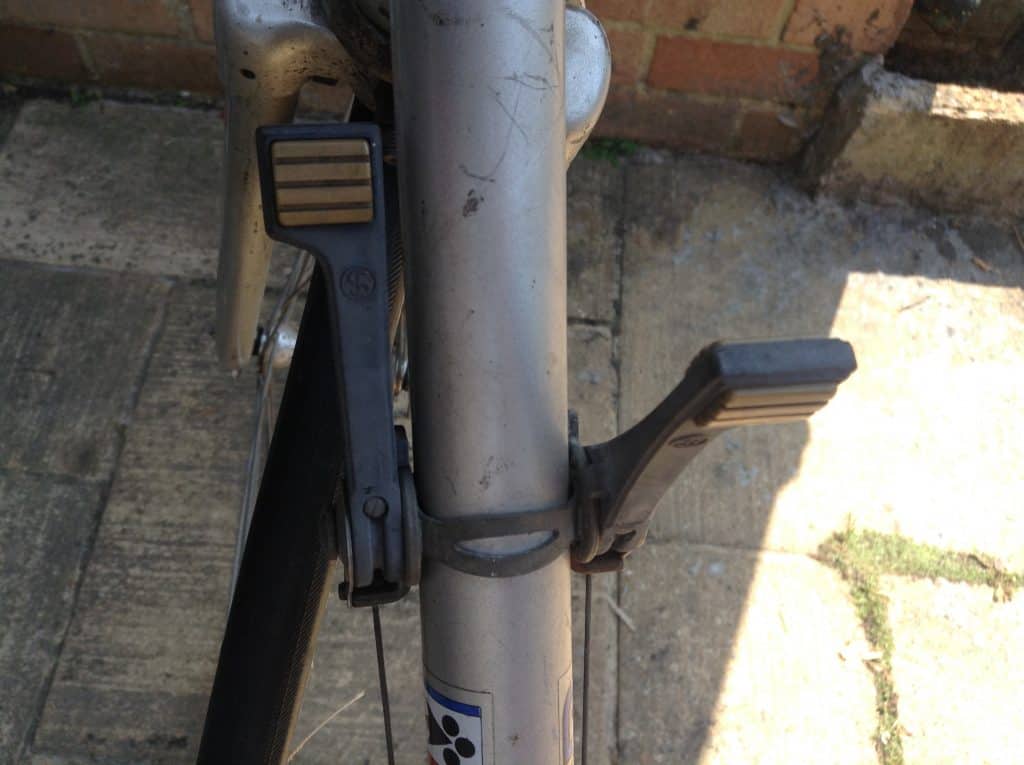Moving the Masses
The Huret Allvit was a workmanlike transmission set and could never be described as inspiring or beautiful. It was mass produced for millions of cheap bikes in the 1970’s, including my own first bike as a kid. From the big French brands like Peugeot and Motobecane, to Raleigh and the American giant Schwinn, the Allvit’s simplicity and rudimentary design was a familiar sight on a whole plethora of entry level models of the era. Friction shifting may have been a battle with this derailleur set, but the Allvit’s introduction in 1958 had helped revolutionise the simple gear shifting of the bicycle. The problem is, they never developed the Allvit as it progressively aged through the latter part of its life.
Performance
Let’s face it, this 1977 Allvit does little to enhance the look of your bike, 20 years after its first introduction. It’s looks reflects its purpose; to do the functional job of shifting across a 5 speed freewheel. Indeed, I remember it always being noisy, the rear derailleur would clunk the chain on the next cog with no dexterity or smoothness. It was prone to slipping out of gear. As far as looks, the long shifter levers are the worst; they don’t belong on road bikes, even heavy ones, and looked even worse when mounted on stems instead of the downtube. The front derailleur looks the best of the bunch, I like its timeless simplicity, but the rear derailleur is a paradigm of brute ugliness, mounted to the frame by a claw and weighing nearly 430 grams ( compared to 275 grams for a Simplex Prestige ).
Changing a Shifter Cable
What should be more simple than removing a friction shifter cable from your downtube shifter lever? It seems that Huret didn’t prioritise mechanical practicality in the later generations of the Allvit. Instead of just pulling a cable through a hole to release it, the Allvit gives you the annoying extra job of having to loosen the actual lever from its mounting, just so you can get the cable out. Crucially, that’s not good design, and it was only a matter of time before the Japanese brands took over the market with their cheaper and more efficient shifter sets, like the Suntour GT.
But it’s not all that bad
I’ve mentioned how uncool and ugly those Allvit shifter levers were if you had them on your bike in the late 1970’s or early 1980’s. However, I believe the winner of ugly friction shifters has to go to Simplex and their full commitment to plastic in these shifters below. I can’t say a good thing about them, and it truly shows how wrong Simplex got it in the latter part of their existence as one of the giants of the bike part world. At least the Allvit was free from plastic, and you didn’t have the chance of suddenly finding half a plastic lever in your hand after pushing too hard. My conclusion is, that the design of the Allvit components neither inspired the idea of effortlessness or precision, and neither were they pitched to compete with a new generation of derailleurs. The heavy and ungainly looking parts had aged too much, and it was time for Shimano and Suntour to take over.






A few things to note. While the Alvit may have been the mechanical embodiment of Brutalism, it had a few redeeming attributes, some of which were eliminated in later years. First, you could completely dismantle both derailleurs, clean and adjust them and get them working just as poorly as they did when brand new. Of course, this also meant that there were small parts that could fall off. Second, they had wicked cool ball bearing jockey wheels that were almost impossible to adjust without a very thin cone wrench. I still have the Sturmey Archer wrench I ground down for this purpose. You needed those long levers to shift into the low gears. I once partnered a wide-range Alvit with Suntour barcons and I don’t think I ever managed to shift the rear derailleur into the 32. Finally, most of the bad shifting characteristics were a result of the freewheel and chainring designs of the day. Combined with flexy frames, any derailleur would have a hard time shifting them and keeping them in gear. One of the major flaws of the Alvit was its rigid body, which when combined with the malleable steel they used was easily bent if the bike landed on its right side. This changed the geometry of the unit and could put the changer into the spokes on the next shift into low. That’s one of the reasons Schwinn used such a heavy duty spoke protector. Both Huret and Simplex created an environment during the Bike Boom in which the Japanese were not seen so much as competition, but as the cyclist’s savior from bad French engineering.
From what I’ve read of the Huret Allvit by another source, you can’t take apart the Allvit, but the other comment says you can. Someone clearly does not know what they’re talking about.
I’ve taken many Allvits apart, so perhaps the other source is referring to the versions from the late ’70s that replaced the bolts and nuts with rivets.
Great points, thanks for your thoughts on the Alvit derailleur group.